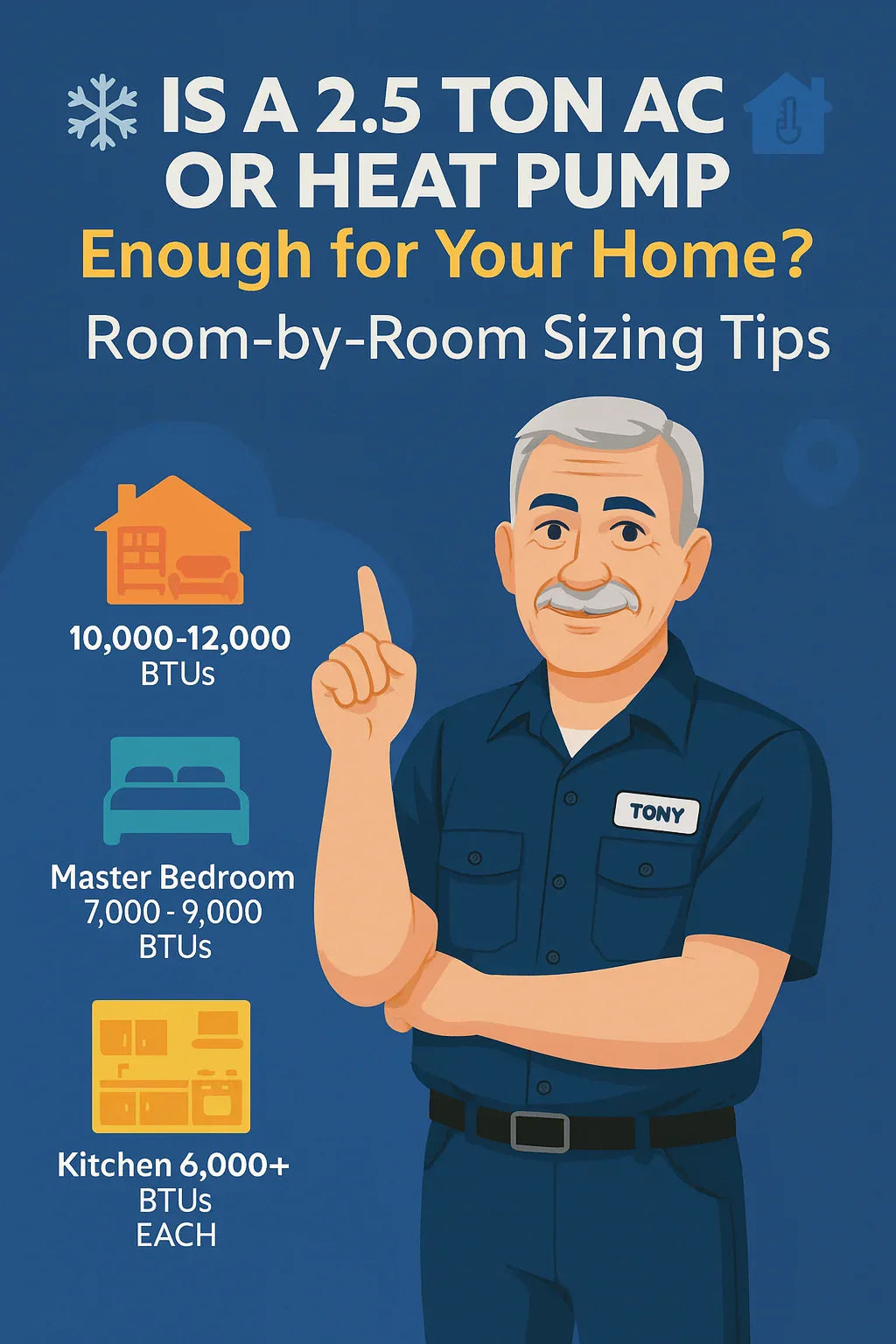Whether you’re upgrading an aging HVAC system or outfitting a newly built home, sizing your air conditioning or heat pump system correctly is critical to comfort, efficiency, and long-term performance. One of the most common sizes for mid-sized homes is the 2.5-ton system, offering around 30,000 BTUs of cooling power. But is it enough for your home?
In this guide, we’ll break down what a 2.5-ton system really means, how to assess your home’s cooling/heating needs by room, and the red flags of both under- and over-sizing.
🏠 What Does “2.5 Ton” Really Mean?
In HVAC, “tonnage” doesn’t refer to weight—it refers to cooling capacity. A ton equals 12,000 BTUs (British Thermal Units) per hour. So a 2.5-ton system can remove 30,000 BTUs of heat per hour from your home.
This is typically sufficient for:
-
1,000 to 1,500 sq ft in moderate climates
-
Smaller homes in hotter climates (like Texas or Florida)
-
Larger homes in cooler regions (like the Pacific Northwest)
🔗 Learn more from Energy Vanguard: What Is a Ton of Cooling?
📏 Square Footage Sizing Estimates
While there are many variables (insulation, sun exposure, ceiling height), a rough starting point is 20 BTUs per square foot.
| System Size | BTUs | Approx. Square Footage |
|---|---|---|
| 1.5 Ton | 18,000 | 600–900 sq ft |
| 2 Ton | 24,000 | 800–1,100 sq ft |
| 2.5 Ton | 30,000 | 1,000–1,500 sq ft |
| 3 Ton | 36,000 | 1,200–1,800 sq ft |
📊 Here's a helpful graphic comparing tonnage to square footage coverage:

🧮 Room-by-Room BTU Breakdown
A 2.5-ton system provides 30,000 BTUs per hour. Here's how that might be distributed across a typical home:
-
Living Room (400–500 sq ft): 10,000–12,000 BTUs
-
Master Bedroom (300–400 sq ft): 7,000–9,000 BTUs
-
Additional Bedrooms (2 @ ~200 sq ft): 4,000–5,000 BTUs each
-
Kitchen (200–300 sq ft): 6,000+ BTUs (due to appliances)
-
Bathroom, Hallways, Entryways: 2,000 BTUs total
🌀 Visual distribution of BTUs in a 2.5-ton system:

🌦 Climate Matters: What Zone Are You In?
Your climate zone directly affects the load your HVAC system must handle.
-
Hot-humid (Florida, Texas): May need a larger system for the same square footage
-
Dry-heat (Arizona, Nevada): May need slightly less due to lower humidity
-
Cold regions (Minnesota, Maine): Heating load more critical than cooling
Use the official DOE climate map to determine your zone:
🔗 U.S. Climate Zone Map (DOE)
🧱 Other Sizing Factors You Shouldn’t Ignore
-
Insulation Quality
Older homes with poor insulation may require more BTUs. -
Window Size and Type
South-facing or single-pane windows let in more heat. -
Ceiling Height
More air volume means more BTUs needed. -
Ductwork Efficiency
Poorly sealed or undersized ducts waste energy.
🔗 Read more on duct sizing from HVAC.com
🚩 Signs Your 2.5 Ton System Might Be Too Small
-
AC runs continuously but barely cools the space
-
Uneven temperatures between rooms
-
High humidity levels indoors
-
Electric bills spike during summer months
🚩 Signs It Might Be Too Big
-
Short cycling (frequent on-off behavior)
-
Uneven comfort, especially near vents
-
Poor dehumidification
-
Higher upfront cost and wear on components
🛠 Manual J: The Gold Standard of Sizing
A professional HVAC installer should run a Manual J load calculation, which considers:
-
Orientation
-
Windows and doors
-
Duct losses
-
Internal heat gains (appliances, people, etc.)
-
Air infiltration rates
🔗 Learn more from ACCA (Air Conditioning Contractors of America)
🔁 What If You Have a Heat Pump Instead?
Heat pumps provide both heating and cooling. While cooling loads are fairly straightforward, heating loads vary widely by region.
In cold climates, the 2.5-ton unit may require supplemental heat strips or a backup furnace to maintain indoor temps during winter.
🔗 ENERGY STAR: How Heat Pumps Work
🧰 Sample Home Layout for a 2.5 Ton System
Home Specs:
-
1,400 sq ft
-
3 bedrooms, 2 baths
-
Open-plan kitchen/living/dining
-
Located in Zone 3 (Midwest)
-
R-13 walls, R-38 attic, double-pane windows
Conclusion: A 2.5-ton unit with good airflow and balanced ducting is likely sufficient.
🔚 Final Takeaway: Is 2.5 Tons Enough?
✅ It’s likely a good fit if your home is:
-
1,000–1,500 sq ft
-
In a moderate climate
-
Well-insulated and energy efficient
🚫 It may not be enough if:
-
You have high ceilings, large south-facing windows, or poor insulation
-
You live in a very hot region
-
You’re heating in cold climates with a heat pump only
Always get a professional sizing evaluation—especially for long-term performance and efficiency.
In the next topic we will know more about: How to Size Your Furnace Correctly: BTUs, Climate Zones & Home Age Matter







